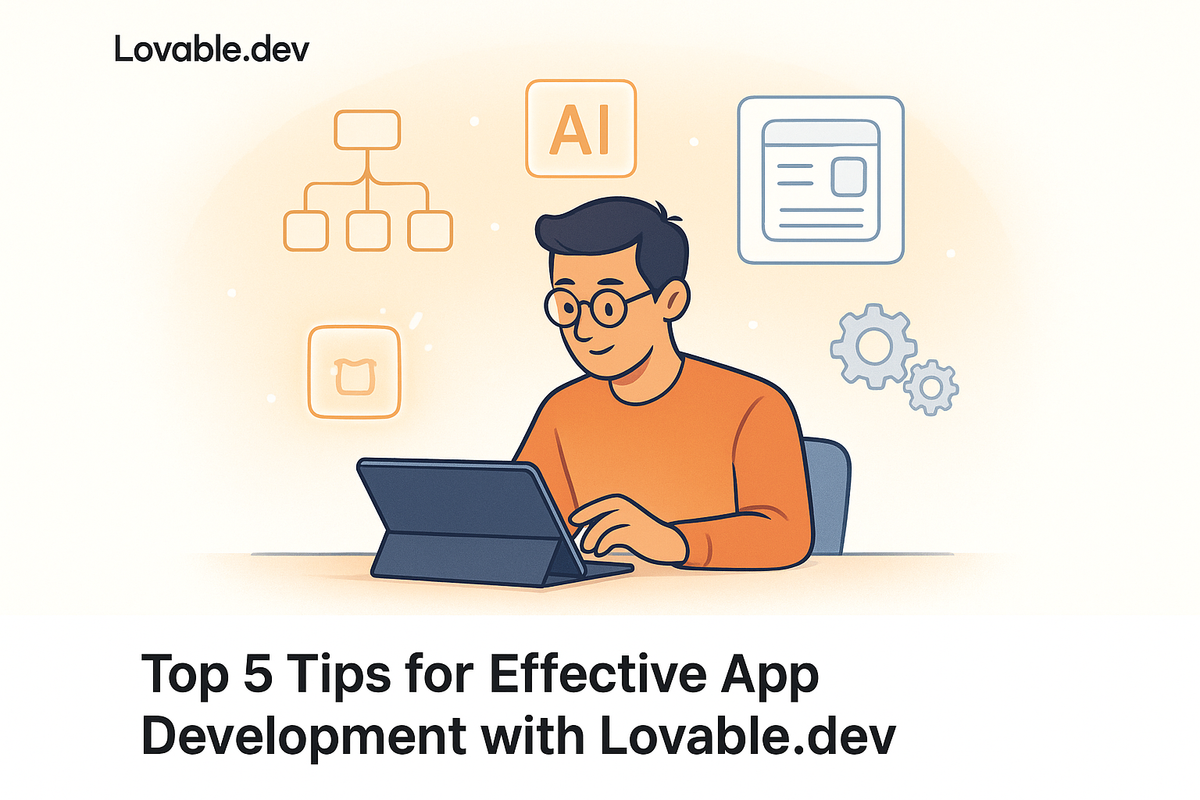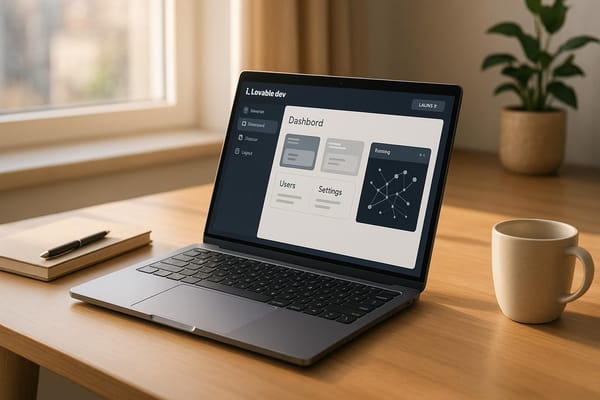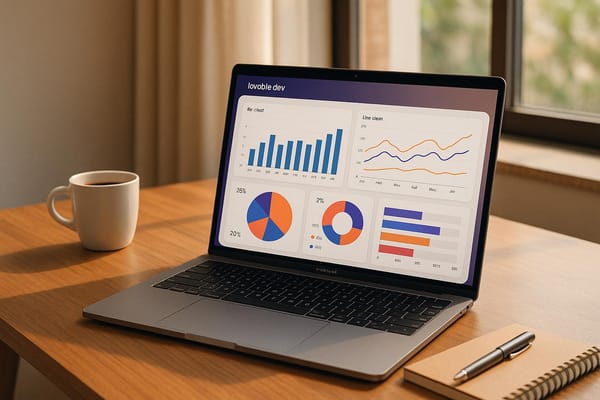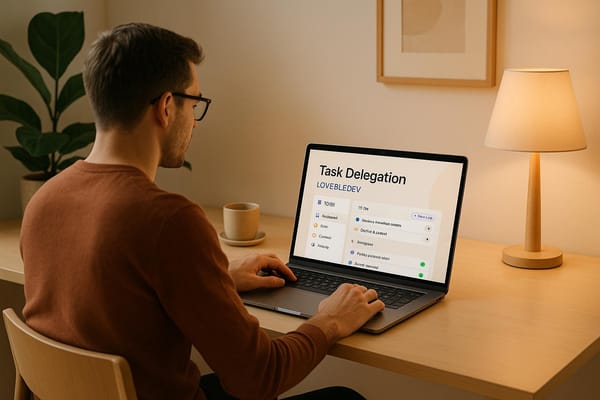Top 5 Tips for Effective App Development with Lovable.dev
Learn how to develop apps effectively with AI tools, from planning and building to testing and launching, using a streamlined no-code approach.

Want to build an app without coding? Lovable.dev simplifies the process with AI-driven tools that handle everything from planning to deployment. Here's how to make the most of it:
- Plan First: Define your app's goals, user needs, and roadmap using Lovable.dev's AI tools.
- Create a Knowledge File: Centralize app details like user profiles, features, and design rules for better AI suggestions.
- Choose Your Build Method: Start with a Design-First or Backend-First approach based on your app's needs.
- Leverage Built-in Tools: Use pre-built components, integrate external services, and test your app thoroughly.
- Gather Feedback Early: Test prototypes with users, act on their input, and refine your app.
Quick Summary:
| Step | Key Action |
|---|---|
| Plan Your App | Define goals, user needs, and features. |
| Knowledge File | Organize app details to guide AI. |
| Build Method | Choose Design-First or Backend-First. |
| Use Tools | Work with pre-built components and integrations. |
| Feedback | Test with users and improve based on insights. |
Start small, test often, and let Lovable.dev's tools guide you from idea to app launch.
How To Build A $25000 APP in 78 Minutes (AI + No-Code)
Tip 1: Plan Your App Before Building
Jumping straight into development might seem tempting, but thoughtful planning can save time, money, and effort while ensuring your app addresses real user needs. Here's how to approach the planning stage effectively with Lovable.dev's tools.
Define Your Goals and Understand Your Users
Start by pinning down the app's main purpose and identifying your audience. The goal is to solve a specific problem, not to cram in unnecessary features. Consider these questions:
- What problem does your app solve?
- Who will use it?
- What outcomes do you want users to achieve?
Write down your answers in Lovable.dev's project workspace. Their AI tools can guide you in outlining product plans and crafting detailed user profiles, setting a clear direction for development.
Use AI to Streamline Brainstorming
Lovable.dev's AI assistant can speed up the planning process. These tools help you:
- Build detailed user personas for your target audience.
- Create feature lists tailored to user needs.
- Map out user journeys to highlight key interaction points.
| Planning Step | AI Tool | What It Provides |
|---|---|---|
| User Research | Persona Generator | Profiles with demographics and behavior insights |
| Feature Planning | Requirements Analyzer | A prioritized list of essential features |
| User Flow Design | Journey Builder | Visual maps of user interactions |
Build a Project Roadmap
Once you've got your research and ideas in place, it's time to create a project plan. Lovable.dev makes this easier by:
- Breaking features into smaller, manageable tasks.
- Setting achievable milestones to monitor progress.
- Highlighting technical dependencies early on to avoid surprises.
Their project planning tools let you create a timeline that includes space for testing and revisions. This ensures you stay focused on the app's most important features while remaining flexible enough to adapt to user feedback.
Tip 2: Set Up Your Knowledge File
The Knowledge File serves as the central hub for your app in Lovable.dev, ensuring precise AI suggestions and a streamlined workflow.
Build a Knowledge Base That Covers All the Essentials
Your Knowledge File should include detailed information about every aspect of your app. Organize it into these core sections:
| Section | Content Type | Purpose |
|---|---|---|
| User Profiles | Demographics, behaviors, needs | Informs UI/UX decisions |
| App Objectives | Core goals, success metrics | Keeps development on track |
| Design Rules | Style guide, UI patterns | Ensures visual and functional consistency |
| Feature Specs | Technical requirements, APIs | Guides implementation |
For instance, if you're working on an expense tracking app, your Knowledge File should include details about your target audience, features like receipt scanning, design preferences, and database requirements. Once you've outlined these basics, you can use AI to expand and refine your file.
Let AI Fill in the Blanks
A well-prepared Knowledge File helps AI provide better support throughout the development process. Here’s how to make the most of it:
1. Start with the Basics
Include your app’s main concept and let AI prompts help identify and fill in any missing details.
2. Refine Through AI Suggestions
Use AI to improve your Knowledge File by drawing inspiration from similar successful projects.
3. Keep It Consistent
Review AI-generated content to ensure it aligns with your app’s goals and uses consistent terminology.
Pro Tip: Keep your Knowledge File up to date. Document every new feature or user insight as your project grows to ensure AI continues to provide accurate and relevant assistance.
Tip 3: Pick Your Build Method
The way you build your app in Lovable.dev can greatly influence its success. Let’s break down the two main approaches: Design-First and Backend-First.
Design-First vs. Backend-First Methods
The Design-First approach focuses on creating the user interface (UI) and prototypes early on. It’s perfect for apps where visuals and user feedback are key. On the other hand, the Backend-First approach prioritizes building the core functionality and infrastructure. This method works well for apps that rely on complex data handling or strong backend systems. Your choice should depend on what your project needs the most.
How to Choose the Right Method
Here’s how to align your approach with your project’s requirements:
-
Understand Project Complexity
For simpler, customer-facing apps, Design-First is great. If your app needs to handle complex data or advanced processing, Backend-First is the way to go. -
Evaluate Your Team’s Strengths
If your team excels in UI/UX design, Design-First will feel natural. If they’re more experienced with system architecture, Backend-First will be a better fit. -
Consider Your Timeline
Need quick visual progress? Design-First allows you to create prototypes fast. If you’re building for long-term functionality, Backend-First helps you establish a solid base early on.
Pro Tip: If you’re new to app development or working on a simple project, start with Design-First. It’s easier to see progress quickly, and you can refine your app as you go. You can also combine both approaches - developing user-facing features alongside backend functionality - for a more balanced strategy.
Once you’ve chosen your method, you’re ready to take advantage of Lovable.dev’s built-in tools to bring your app to life.
Tip 4: Use Built-in Tools Effectively
Once you've settled on your development approach, make the most of Lovable.dev's built-in tools to simplify and speed up your process.
Work with Pre-Built Components
Lovable.dev's visual editor includes a library of pre-built components that save time and effort. These components are crafted to balance function with style, giving your app a polished, professional appearance.
Here’s a breakdown of the available component types:
| Component Type | Use Case | Key Features |
|---|---|---|
| UI Elements | Basic interface building | Forms, buttons, cards, navigation bars |
| Smart Components | Complex functionality | Data tables, authentication flows, payment forms |
| AI-Enhanced Blocks | Advanced features | Chatbots, recommendation engines, content generators |
To work more efficiently:
- Start with the base components that fit your needs.
- Use the component search tool to quickly find what you’re looking for.
- Customize components and save them as templates for future use.
Connect External Services
Enhance your app by incorporating third-party services. Lovable.dev’s integration system makes this process simple and secure, allowing you to expand your app’s capabilities without hassle.
Pro Tip: Always use environment variables to store sensitive information like API keys and access tokens. Lovable.dev’s environment manager provides a secure way to handle credentials while ensuring they’re accessible within your app.
For seamless integration:
- Test connections in a staging environment before going live.
- Keep an eye on API usage to avoid unexpected issues.
- Set up proper error-handling mechanisms to catch and resolve problems quickly.
Test and Launch Your App
Before launching, test your app thoroughly using Lovable.dev’s built-in testing tools:
- Preview Mode: Check how your app looks and functions on various devices.
- Performance Analytics: Track load times and optimize where necessary.
- User Flow Testing: Ensure all user paths work as intended.
- Cross-browser Compatibility: Verify that your app behaves consistently across different browsers.
When you're ready to launch, follow these steps:
- Go through the pre-launch checklist to ensure everything is in place.
- Configure deployment settings for your app.
- Set up monitoring alerts to stay informed about performance and issues.
- Roll out your app gradually to minimize risks and gather feedback.
Tip 5: Get User Feedback Early
Collecting feedback early on helps you fine-tune your app and align it with user expectations. These insights can guide meaningful updates and improve the overall user experience.
Test with Your Target Audience
Share a simple prototype with your intended users to see how they interact with it. This can reveal how easy it is to use and whether the features are meeting their needs. Early testing ensures your app develops in a direction that resonates with your audience.
Act on Feedback Quickly
Address feedback as soon as possible. Focus on the most critical issues, test changes using preview tools, and keep track of each update to measure its impact. This approach keeps your development process focused and efficient.
Engage with Other Developers
Join the Lovable.dev community to swap stories, learn from others, and discover new ideas. Engaging with fellow developers can inspire fresh approaches and speed up your app's progress.
Conclusion: Next Steps
Take these steps to build effective apps using Lovable.dev. These guidelines will help you move forward with confidence.
Here’s your action plan:
- Review your project roadmap: Clearly outline your app’s features and target audience. Use Lovable.dev’s AI tools to refine your concept and create a detailed plan.
- Build your knowledge file: Set up a solid foundation for your app on Lovable.dev. The platform acts like your personal full-stack engineer, helping you turn your idea into a working app.
- Share your progress: Post updates in the "From the Community" section. This not only helps you learn from others but also inspires fellow developers.
App development is a process. Start small, test often, and grow based on user feedback. With Lovable.dev’s resources and these steps, you can bring your app idea to life and make it a success.
FAQs
How can Lovable.dev's AI tools support me in planning my app development process?
Lovable.dev's AI tools simplify the initial stages of app development by helping you outline your app's structure, features, and functionality. Using AI-driven workflows, you can quickly generate prototypes, identify key components, and refine your app idea without needing extensive technical knowledge.
These tools also provide personalized recommendations based on your goals, ensuring your app is user-friendly and efficient. By leveraging Lovable.dev's capabilities, you can save time and focus on creating a better experience for your users.
Why should I use a Design-First approach instead of a Backend-First approach when developing apps with Lovable.dev?
A Design-First approach focuses on creating the user interface and experience before diving into backend development. This method is especially effective with Lovable.dev because it allows you to prioritize user-centric design and ensure the app feels intuitive and engaging from the start. By visualizing your app early, you can identify potential usability issues and make adjustments before investing time in backend logic.
On Lovable.dev, this approach also streamlines development by leveraging its no-code tools and AI-driven workflows to quickly prototype and refine your app’s design. Once the front-end is polished, integrating backend functionality becomes faster and more aligned with the app’s overall goals. This helps indie makers and small teams save time, avoid rework, and deliver apps that users love.
What are the benefits of creating a Knowledge File on Lovable.dev for app development?
Creating a Knowledge File on Lovable.dev streamlines your app development by organizing essential data and resources in one place. It enables you to store, manage, and retrieve structured information that your app can use dynamically, reducing repetitive tasks and improving efficiency.
With a Knowledge File, you can tackle common challenges like data consistency, scalability, and logic centralization. This feature is especially helpful for indie makers and small teams, allowing you to focus on building great user experiences without getting bogged down by complex backend setups.



